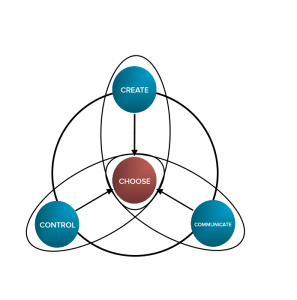
How does Do You See Clearly work?
Changes or projects can be executed with different frameworks like Prince, PMBOK, Agile, Scrum, Lean, Sourcing , Life Cycle Management a.o. But in all these approaches some basic patterns can be seen.
Want to know more about this basic patterns behind all frameworks see
Using our model with basic patterns for every change, we build a looking glass to assess the state of our programme or project stands. The 4 components leads to 4 key questions.
The 4 key questions
- Is it true what we create?
- Are all involved moved or inspired?
- Do we control execution?
- Do we make real and good choices on all aspects?
These 4 key questions can be asked for every phase of the cycle of the 4 components, because we have seen that all components follow their own dynamics and velocity in their cycle with 5 phases.
DYSC Scores
Now for each score area you are asked:
Is delivery at risk because there is anything (based on thought, feeling or fact) that can jeopardise or harm result: red, amber, green. Weighing what’s important comes later, first assemble observations.
The true result comes from participation of as many as possible, whatever difference in role, position, expertise, involvement or anything else. With this we will have a consolidated and specified view that helps us in discovering relevant observations, especially those we did not see, but really are relevant.
The score for each area is presented in colour and a weighted number. The scores red-amber-green have number values 0-5-10. The weighted score is the average scores of all participants.
In collecting and presenting data we focus on
- Date of filling in during lifecycle of the project
- Role of the participants
- Organisational position of the participants
Date
By filling DYSC’s during the lifecycle of a project we see how scores are developing or change. So possibly, what first gave no doubt, it gives now or what first was doubtful now no longer.
Here we see an example how scores developed during the time:
Role
Our view on projects is influenced by our role we play in respect of the project. A role always gives a special view based on our background, experience and expertise coming from that role we play.
The roles we distinguish in DYSC are
- The funder: those that belong to the party that pays for the investment of this project
- The demand: those who specify the requirements for their business and operations
- The architect: those who develop the solution to be build
- The supply: those that design, build, test and implement all building blocks of the specified solution
- The programme/project manager: those assigned to manage all aspects in assuring the accomplishment of the project
Here we see example how score can differ between role players in the same project.
Position
Another element that can have impact on how we see things is our organisational position. As with our role our background, experience and expertise can influence our observations.
The different organisational position we distinguish in DYSC are:
- Senior management: those on top level of the organisation that have role regarding the change
- Middle management: those responsible for (sub)departments in the organisation that have role regarding the change
- Team leads: those leading delivery teams within the change on whatever expertise field
- Staff members: those that are delivering experts within the change on whatever field
- Outside: those who have no role what so ever in the change and views it from the outside
Here you see an example how scores are presented dependent on the organisational position.
DYSC reports
But we are not only interested in the scores but also why the score was given by the participant. What was the specific subject of his concern or reason for his score.
That’s why the reports in DYSC not only show the scores but also the specifications given by the participants for their score. With these you can investigate and assess deeper to discover what’s real and need action.
Combining all views after collecting data from a number of respondents the following reports can be presented.
Through these user friendly short and simple reports we can present a common but still specific view on our project with which a joined evaluation is possible to define necessary actions.
Interested to be Do You See Clearly? See DYSC Application or request a DEMO.










